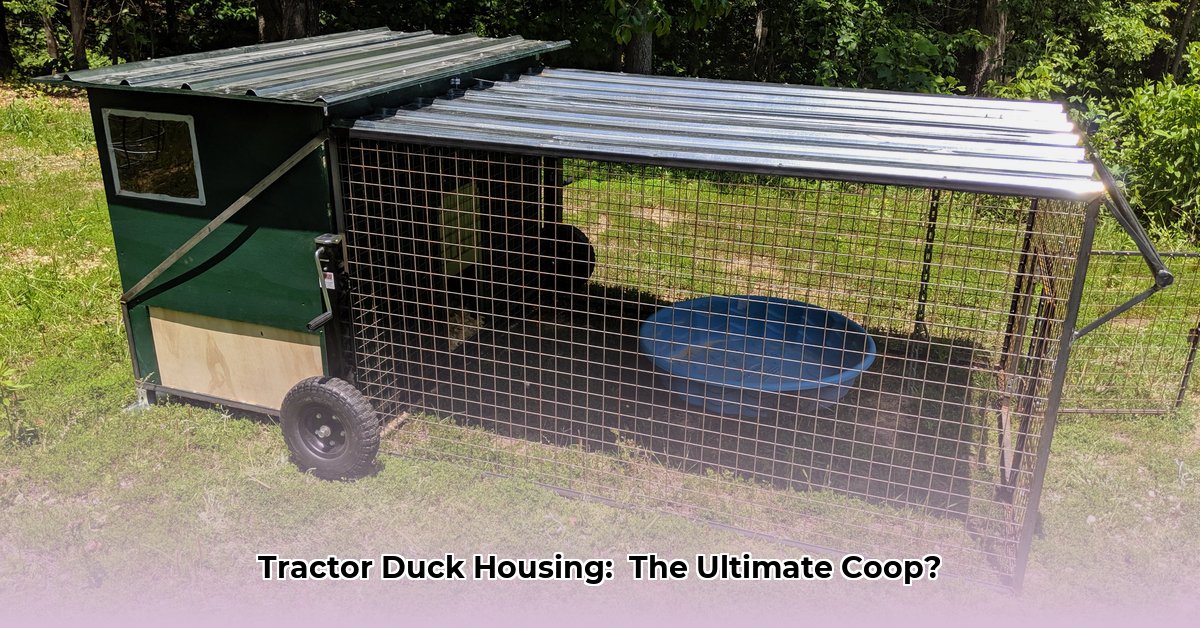
Raising ducks for sustainable agriculture offers numerous benefits, but providing appropriate housing is paramount. This guide offers practical, actionable steps to design and build the ideal coop for your flock, considering factors like budget, space, climate, and predator protection. We'll explore various coop designs, sustainable material choices, and essential maintenance practices for a thriving duck operation. For supplemental duck feed options, check out this helpful resource.
Choosing the Right Coop Design: Tailoring to Your Needs
The perfect duck coop depends on several key factors: your budget, flock size, location, and climate. Let's examine different design options to find the best fit for your needs.
Budget-Friendly DIY Options:
Pallet Coops: A cost-effective starting point. Repurposed pallets provide a readily available, cheap building material. However, always use treated lumber to prevent rot and ensure structural integrity (the strength and stability of the structure). Regular inspection is vital for early detection of wear and tear; reinforcement may be necessary, especially with larger duck breeds. Do you want a quick, economical solution, or are you willing to invest more time and resources for increased durability?
Repurposed Structures: Transform existing structures like sheds or sturdy storage crates into duck housing. Thorough inspection for damage and decay is crucial before repurposing. Treating wood with a weather-resistant sealant significantly extends the coop's lifespan. This option maximizes resource efficiency but requires careful assessment of the existing structure's suitability.
Advanced Designs for Experienced Builders:
Mobile Coops: Ideal for pasture rotation, these coops allow you to move ducks to fresh grazing areas, preventing overgrazing and reducing parasite buildup. A robust frame with strong wheels is essential for easy maneuverability. The wheels must support the combined weight of the coop and the ducks. Is pasture rotation a priority for your farming practices?
Floating Coops: Suitable for water access, these coops offer a natural environment for your ducks while protecting them from land predators. However, stability and security are paramount to prevent drifting or capsizing. Strong moorings and waterproof construction are absolutely essential. Will your ducks have access to water, and are you prepared for the unique challenges of a floating coop?
Selecting the Right Materials: Sustainability in Action
Sustainable farming prioritizes eco-friendly materials. Whenever possible, utilize recycled or reclaimed materials like repurposed pallets or upcycled wood. Prioritize durability for longevity and reduced waste. While DIY saves money, high-quality materials translate to a longer-lasting coop. What balance between cost and long-term durability are you aiming for?
Shielding Your Flock: Predator Protection Strategies
Protecting your ducks from predators is crucial. Implement a multi-layered approach:
- Sturdy Wire Mesh: A primary defense against opportunistic predators.
- Secure Latches: Prevent unauthorized entry.
- Elevated Placement: Raising the coop makes it harder for ground-dwelling predators to reach your ducks.
Regularly inspect for any damage or weaknesses. What level of predator protection is necessary in your specific location?
Maintaining Your Duck Haven: Cleaning and Upkeep
Regular cleaning prevents disease and promotes duck health. Design your coop for easy waste removal. This might include removable trays or easily cleaned floors. A consistent cleaning schedule is essential. How will you integrate cleaning into your daily or weekly routine?
Budgeting for Your Duck Coop: A Cost Breakdown
Costs vary depending on design complexity and materials. DIY projects are generally budget-friendly, but factor in materials, tools, and unforeseen expenses. Remember, a well-built coop is an investment in your ducks' well-being. How much are you willing to invest in your duck's housing?
Environmental Considerations: Minimizing the Footprint
Sustainable farming minimizes environmental impact. Consider the coop's life cycle: materials sourcing, construction, and disposal. Opt for easily recyclable or compostable materials where possible. Mobile coops offer additional land management benefits. What environmental impact are you aiming to minimize?
Navigating Local Regulations: Legal Compliance
Check local building codes and zoning ordinances before starting construction. Regulations may restrict certain designs or materials. Compliance is crucial to avoid potential penalties. Have you researched and understood the local regulations in your area?
Assessing the Risks: Preparing for the Unexpected
Different coop designs carry unique risks. The following table summarizes potential issues and mitigation strategies:
| Design Type | Potential Risks | Mitigation Strategies |
|---|---|---|
| Pallet Coop | Structural collapse, rot | Use treated wood; reinforce structure; regular inspections |
| Mobile Coop | Wheel failure, tipping over | Use heavy-duty wheels; secure construction; regular checks |
| Floating Coop | Water damage, instability, sinking | Robust construction; secure mooring; regular inspections; waterproof sealant |
| Repurposed Structure | Material degradation, structural instability | Thorough inspection; material pre-treatment; reinforcement as needed |
Building the perfect tractor duck coop requires balancing budget, duck needs, and environmental sustainability. Remember that planning and careful consideration of all factors will help you build a coop that efficiently meets your ducks' welfare and your agricultural goals.